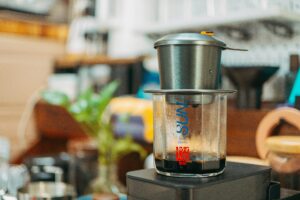Have you ever enjoyed a steaming cup of coffee only to be left with an unsettling acidic aftertaste? Or perhaps you’ve experienced stomach discomfort after your morning brew? If so, you’re not alone. Many coffee lovers grapple with the acidity of their favorite drink, which can affect both flavor and digestion. This guide aims to help you understand and reduce the acid in your coffee, making your daily cup gentler on your stomach and more enjoyable.
In this blog post, we’ll explore why coffee is acidic, how it affects your body, and practical ways to reduce its acidity. Whether you’re a casual sipper or a die-hard coffee aficionado, these tips will help you enjoy your coffee without the burn.
What Makes Coffee Acidic?
The Science Behind Coffee Acidity
Coffee naturally contains a variety of acids, including chlorogenic acid, quinic acid, and citric acid. These contribute to its distinct flavor and aroma. However, these acids can also lead to that tangy taste and potential stomach irritation.
The Role of Coffee Beans
The type of coffee bean plays a significant role in acidity. Arabica beans are generally more acidic compared to Robusta beans. The region where the coffee is grown also impacts acidity levels, with beans from high-altitude areas usually having higher acid content.
Brewing Methods and Their Impact
How you brew your coffee can influence its acidity. For instance, methods that require longer brewing times, like French Press, tend to extract more acids, making the coffee more acidic.
Health Impacts of Acidic Coffee
Digestive Issues
Acidic coffee can irritate the stomach lining, leading to discomfort and even acid reflux. Those with sensitive stomachs often find high-acid coffee unbearable.
Dental Health
The acids in coffee can erode tooth enamel over time, leading to increased sensitivity and cavities. Using a straw can help minimize contact with teeth, but reducing the coffee’s acidity is a more effective long-term solution.
General Well-Being
Excessive acid intake can affect your overall well-being, leading to heartburn and other gastrointestinal issues. Reducing the acidity of your coffee can make a noticeable difference in how you feel.
Choosing Low-Acid Coffee Beans
Arabica vs. Robusta
Opt for Robusta beans if you’re looking for a lower-acid option. While they might have a slightly stronger, more bitter flavor, they are easier on the stomach due to their lower acid content.
Specialty Low-Acid Beans
Many brands now offer low-acid coffee blends specifically designed for those with sensitive stomachs. These beans are processed and roasted in ways that minimize their acid content.
Coffee Growing Regions
Beans from regions like Brazil, Sumatra, and Nicaragua are known for their naturally lower acidity. Consider trying beans from these areas if you’re looking to reduce acid in your coffee.
Mastering the Art of Brewing Low-Acid Coffee
Cold Brew Method
Cold brewing is a game-changer for those seeking to reduce coffee acidity. The cold water extracts fewer acids compared to hot brewing methods, resulting in a smoother, less acidic cup of coffee.
Brewing Time and Temperature
Shorter brewing times and lower temperatures can also help reduce acidity. For example, using a drip coffee maker at a lower temperature setting can yield a less acidic brew.
Water Quality
Using filtered or bottled water can make a difference. Tap water, depending on its mineral content, can increase the acidity of your coffee.
Adjusting Coffee Strength
Grind Size
A coarser grind can help minimize acid extraction during brewing. Experiment with your grinder settings to find the sweet spot that balances flavor and acidity.
Coffee-to-Water Ratio
Altering the coffee-to-water ratio can also impact acidity. Using less coffee per cup of water can result in a milder, less acidic drink.
Double Brewing
Try double brewing your coffee by running it through the machine twice with the same grounds. This technique can help reduce acidity while maintaining a rich flavor.
Incorporating Additives to Neutralize Acid
Dairy Milk
Adding milk to your coffee can neutralize some of the acids, making the drink smoother. The calcium in milk acts as an acid buffer.
Plant-Based Milks
Almond, soy, and oat milk can also help reduce acidity. Each type of milk has its unique flavor, so experiment to find which one complements your coffee best.
Baking Soda
A pinch of baking soda can neutralize coffee acid without altering the flavor significantly. Be cautious with the amount, though—too much can make your coffee taste soapy.
The Benefits of Using Coffee Filters
Paper Filters
Paper filters can capture some of the oily compounds in coffee that contribute to acidity. Switching from a metal mesh filter to a paper one can help reduce the acid content in your brew.
Specialized Low-Acid Filters
There are also specialized filters designed to reduce coffee acidity. These filters often incorporate additional materials that can neutralize acids more effectively than standard paper filters.
Filter Maintenance
Regularly changing and maintaining your coffee filters can prevent the buildup of acidic residues. Ensure you’re using fresh filters to achieve the best results.
Exploring Deacidified Coffee Options
Commercial Deacidified Coffee
Several brands offer deacidified coffee, which undergoes special processing to remove acids. These products are designed specifically for individuals with high acid sensitivity.
DIY Deacidification
You can also deacidify your coffee at home using simple methods like adding alkaline water or using a pinch of salt during brewing. These techniques can significantly reduce the acid levels in your coffee.
Benefits and Drawbacks
While deacidified coffee can be easier on the stomach, some argue that it lacks the complexity and flavor of regular coffee. Weigh the pros and cons to decide if this option is right for you.
FAQs on Reducing Acid in Coffee
Is decaf coffee less acidic than regular coffee?
Decaf coffee tends to be less acidic, as the decaffeination process removes some of the acids along with the caffeine. However, the exact acidity can vary depending on the type of bean and decaffeination method used.
Can I use honey instead of sugar to reduce coffee acidity?
Honey can add a natural sweetness and contains minerals that may help neutralize some of the acids in coffee. However, it won’t significantly alter the overall acidity.
Are there any health risks associated with adding baking soda to coffee?
A small amount of baking soda is generally safe to add to coffee for acid neutralization. However, consuming large quantities can disrupt the acid-base balance in your stomach, so use it sparingly.
Conclusion
Acidic coffee may be a common issue, but it doesn’t have to ruin your coffee experience. By understanding the factors that contribute to coffee acidity and implementing some of the strategies discussed above, you can enjoy a smoother, gentler cup of coffee without sacrificing flavor.
Ready to transform your coffee routine? Start experimenting with these tips and find the perfect balance that suits your taste and health needs. For those who want personalized guidance, our team of coffee experts is here to help. Reach out today and elevate your coffee game to the next level.






